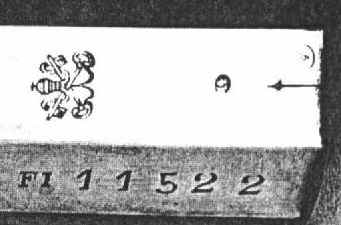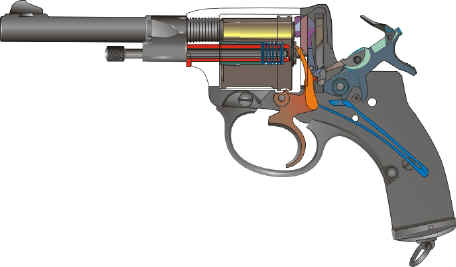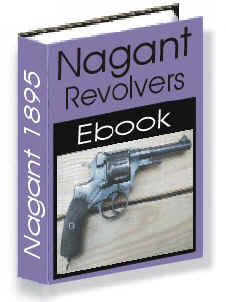The goal here is not to present to you all the historical details of this renowned Belgian firm, but to point out the main steps that contributed to the development and the repute of this armsmaker whose single family name in certain parts of the world became a synonym for handgun. The "Fabrique d'armes Emile et Léon Nagant" was founded in 1859 by two brothers : Emile (born in 1830) and Léon (born in 1833). They built a plant in Liège, Belgium, where they started production in the mechanical field. By 1960, they turned their activity to the production of firearms. At that time, Liège was a major center in the world for the development and production of firearms.
By 1867, the Nagant brothers met Samuel and Eliphalet Remington as they were prospecting throughout Europe to sell their "rolling block" rifles and to find local subcontractors to produce them under license. The Remington's were very impressed by the quality of the work produced by the Nagant's in their plant and proposed to them that they become their subcontractor. The Nagant's accepted the deal and started to produce "rolling block" rifles (5,000 pieces) for the Vatican's guards. These rifles bore a specific marking showing two crossed St Peter's keys on the barrel chamber.
The Nagant brothers were not content with just reproducing of the Remington rifles. They improved the rifle in many ways that were accepted by Remington. One of the most significant improvements was the adaptation of the "rolling block" lock to a double-barrelled shotgun. First fitted with a double trigger, one for each hammer, then with a single one which operated the two hammers in turn. These weapons are known under the name of : "Remington-Nagant". Until 1900, the Nagant's produced rifles inspired by the "rolling block" principle. But in 1876 they also produced an 11 mm caliber rifle for Greece, based on a locking system developed by a Greek Artillery officer, whose name was Enstathios Mylonas. With its falling block, it was rather similar to the Belgian Comblain rifle.
By 1877, a very special - in terms of shape - double-barrelled handgun, including a "rolling block" lock was produced. This weapon was to become the very first metallic cartridge handgun to be accepted by the Belgian Government to equip its Gendarmerie. This quite rare weapon (no more than some 2,000 were built) was kept in service until 1901 when it was replaced by the FN Browning 1900 auto pistol. The pistol was sold on the commercial market until 1910. The cartridge, of 9.4 mm caliber, was created by Bachmann, a Belgian manufacturer. This cartridge is known under the names : 9 mm Belgian or 9.4 mm Nagant. The lead bullet of 12 grams weight was paper patched and inserted into a 22 mm rimmed case with a slight taper. The charge was of 1 gram of very fine black powder (hunting quality) that allowed for a 197 m/s muzzle velocity. Two types of the model 1877 pistol can be found. The first series (until serial number 1050) was built with a two-part receiver as shown on the drawing on the left. After the first series, a one part receiver was used as shown in the second drawing. The exact quantity produced is unknown, but we can estimate it at about 2,000 pieces. These handguns are therefore very rare to find and costly. When replaced by the Belgian Government, these pistols were sold as military surplus to specialized firms. Many were bought by American companies like Bannerman. First type Second type
The 1878 Nagant revolver was the first of a family which met success through its adoption by several European countries and particularly Belgium. Its was available with a single or double action mechanism and was adapted following the specific recommendations of the countries that bought it to equip their Army.
The next model 1883 had an improved single action lock, and the cylinder external surface was plain, without grooves. It was set with a double action lock for Norway and Denmark. By 1886, appeared an improved version of the 1878 model with a simplified lock stemming from the 1883 model. The models 78, 78/86 and 83 were all adopted by the Belgian Army in 9.4 mm caliber. They remained in use until 1940. In 1887, a specific model was adapted in caliber 7.5 mm for Sweden.
The following model 1893 in caliber 7.5 mm was bought by Sweden, Norway and Serbia, and in caliber .44 by Brazil and Argentina.
In 1887, the Nagant firm produced a Mannlicher rifle in caliber 8 mm and 7.65 mm. Due to the complexity of the model, it was replaced by a Mauser system in 1888. Around 1888, the Russian authorities were planning to replace their old one shot Berdan rifles. They contacted the Nagant firm and ask them to develop a new rifle, in 7.62 mm caliber, with the help of Colonel Ivanovith Mosin. As a result, the new rifle, known as Mosin-Nagant, was produced and adopted in 1891. By 1892, the firm also produced Comblain rifles to be exported to Brazil and Argentina. Following the success of the Mosin-Nagant rifle, the firm became very well known and accepted by the Russians. As such, it was called upon when the time had come to think about the replacement of the bulky, large caliber, Smith & Wesson revolvers in use in the Russian Army.
Russian Smith & Wesson revolver The new revolver had to keep the same 7.62 mm caliber used in the Mosin-Nagant rifle. The firm proposed a new model whose innovative technical characteristics obviated to the usual gas escape between the cylinder and the barrel. This model was eventually adopted by the Russians in 1895.
By April 1896, Emile Nagant had become sick, and the two brothers dissolved the company. Immediately, Léon recreated a new company under his own name : "Fabrique d'Armes Léon Nagant". By 1896, Léon and his two sons entered into a new industrial activity : the making of motor cars.
Léon died on February 23, 1900, and the company was then managed by his two sons : Charles (born in 1863) and Maurice (born in 1866). The company's name was changed to : "Fabrique d'Armes et Automobiles Nagant Frères". On December 23, 1902, Emile Nagant died at its turn. Even if by 1910, some improvements were brought to the famous model 1895 revolver, no invention in the firearm field came up any more in the firm until all the tools and licenses to produce the model 1895 were bought by the Polish Radom arsenal in 1928. The above recaps the headlines of the firm's activity. Now we will focus on the Nagant revolver line. The main thrust of this ebook is to provide a detailed study of the famous 1895 "gas seal" Russian model. In Russia, the name of Nagant has the same generic meaning as Colt has when talking about a revolvers in the West. More than 2,000,000 models 1895 were produced up to 1944. Plenty of these obsolete but interesting handguns are now available for a few bucks on the collectable firearms markets. But the whole Nagant revolver line is yet to be known by many collectors. That is why we will propose you in our ebook an overview of the complete Nagant revolver line, that begins with the 1878 model and ends with the 1910 "gas seal" model, equipped with a central extractor and a right-dropping cylinder.
Keep in touch with us to know when this very interesting ebook will be available.
Remington Firearms : The Golden Age of Collecting by Robert W. D. Ball Hardcover - 193 pages (May 1995) Krause Publications; ISBN: 0873413601 ; Dimensions (in inches): 1.07 x 11.69 x 9.11 by Bill West (Compiler), Remington Arms Company Paperback - Bill West c/o John Babbish; ISBN: 0911614095 The Guns of Remington : Historic Firearms Spanning Two Centuries by Howard Madaus, Renee Tafoya (Editor), Paul Goodwin (Photographer), Jan Woods Hardcover (August 1997) Biplane Productions; ISBN: 0965950301 by Terence W. Lapin Paperback - 219 pages 1 edition Vol 1 (September 15, 1998) North Cape Publications; ISBN: 1882391217 The Soviet Mosin-Nagant Manual by Terence W. Lapin Paperback - 143 pages (December 10, 1999) Hyrax Publishers, LLC; ISBN: 0967689600 by James F. Gebhardt (Editor) Paperback - 104 pages (January 1997) Paladin Pr; ISBN: 0873649079 The Official Soviet Mosin-Nagant Rifle Manual by James F., Maj. Gebhardt (Translator) Paperback (July 2000) Paladin Pr; ISBN: 158160081X |
|
|||||||||||||||
Bibliographical and photographical sources : - Revues belges AMI no 1 - 6 - 15 - 22 - 46 - 52 - 66
- The revolver
1865 - 1888 by Taylerson
|
||||||||||||||||



 - The History and
Development of Small Arms Ammunition, George A.
Hoyem, VOL II - Centerfire Primitive and Martial Long Arms, Armory Publications, Tacoma,
1982).
- The History and
Development of Small Arms Ammunition, George A.
Hoyem, VOL II - Centerfire Primitive and Martial Long Arms, Armory Publications, Tacoma,
1982).